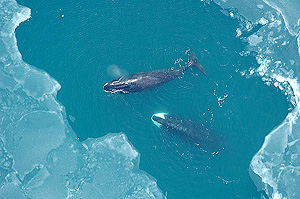A Fleet at Risk
The Arctic Whaling Season was traditionally short because of the potential for severe weather. In 1871, the season was more precarious than usual. The Natived of this region understood the weather patterns and knew that harshness lay ahead. During the summer of 1871, they rowed their boats out to the whaleships warning of what was to come. Since the whalemen didn't always understand the local language, warnings were mostly ignored.
By August, much of the fleet had passed Point Belcher, near Wainwright, Alaska. Conditions were worsening. A stationary high reversed the normal wind pattern pushing the pack ice towards the Alaska coast, while the whalers carried on their work not far from shore.
By early September, the entire fleet's peril became very real as a gale caused the Eugenia to break away from anchor and be driven toward land. Next the Comet was crushed between two masses of ice. Fortunately, all crew members survived and were taken aboard other whale ships nearby, continuing their search for whales. Little did Captain Jernegan know what was next for the Roman.

National Oceanic and Atmospheric Administration